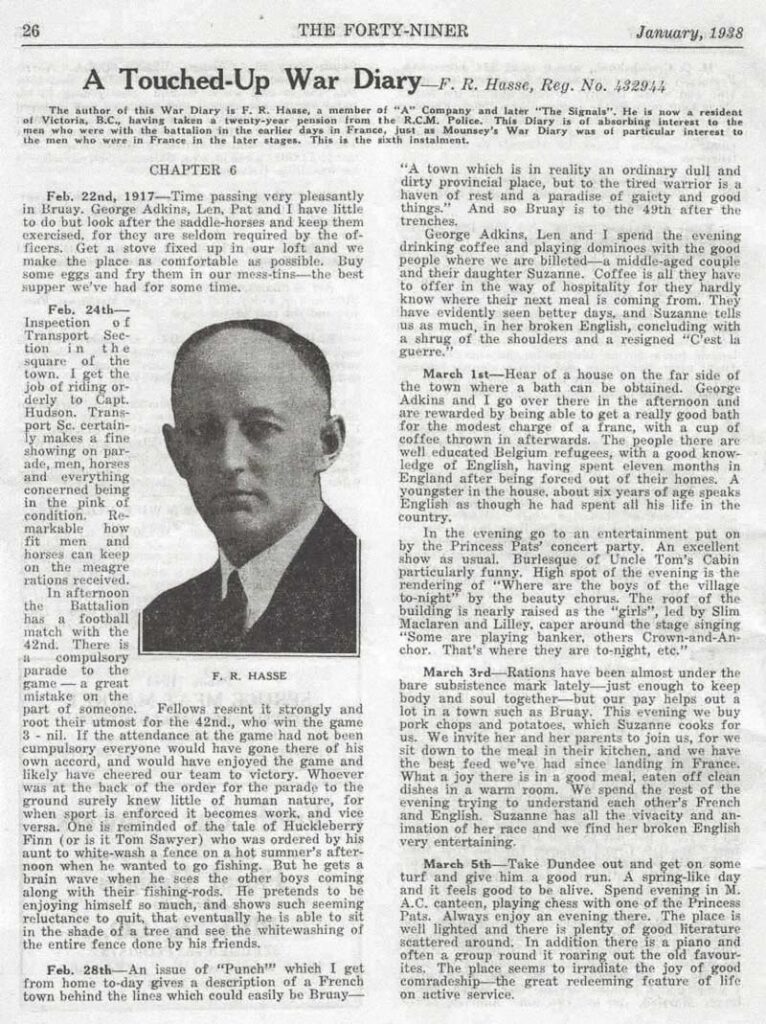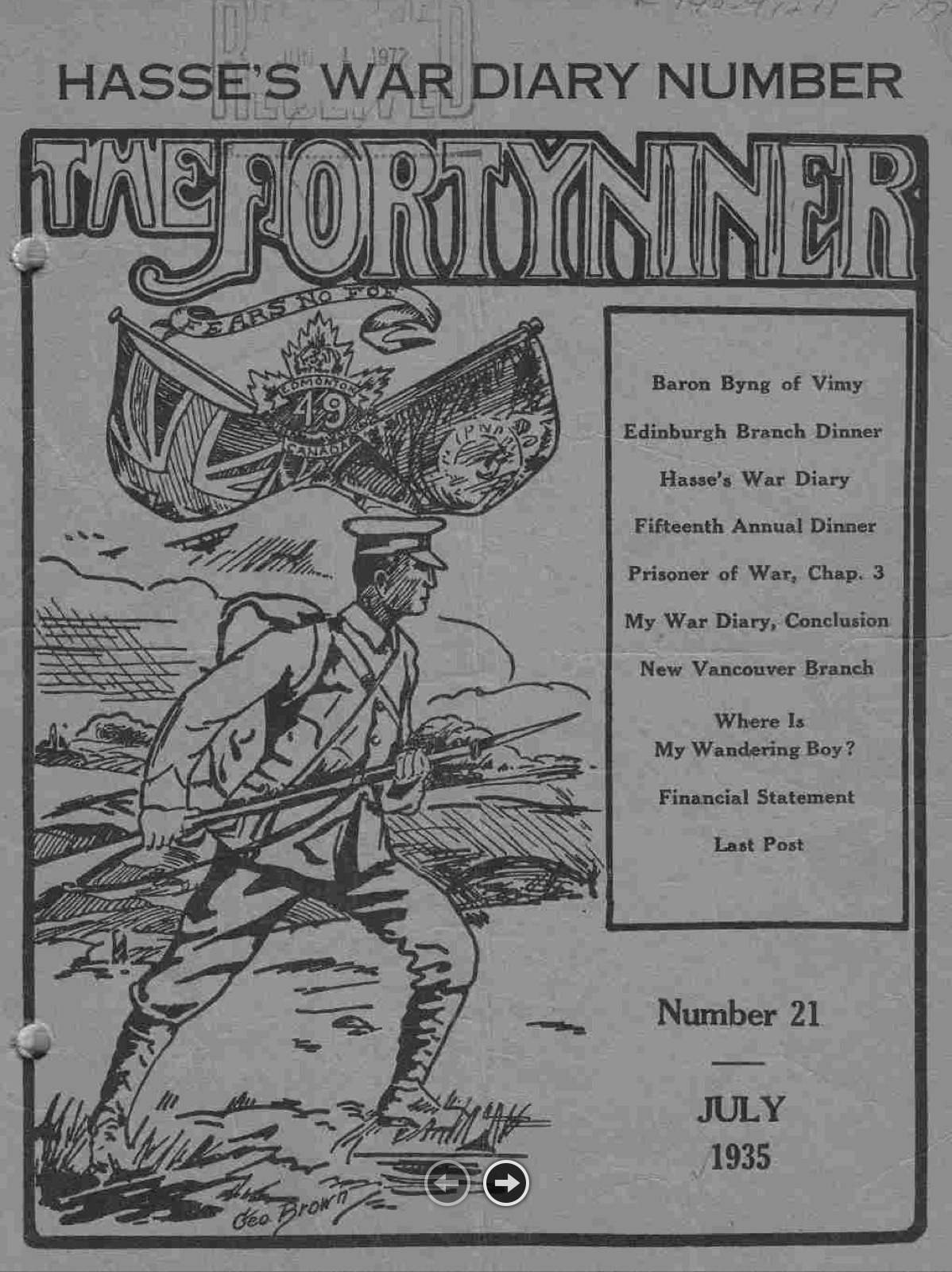Frank Reginald Hasse was the son of the Reverend Lewis St. Aubin Hassé, a Moravian minister who was born in Ireland, and his wife Sarah Louisa Ridgley. Their sons, Frank Reginald (born September 15, 1891) and Edwin Ridgley (born ca. 1894), were born in Kimbolton, Huntingdonshire, England, and homesteaded in Alberta near Lake Wabamum. Both sons enlisted with the 49th Battalion. Edwin was killed in action at the first Battle of the Somme on July 13, 1916 ,at the age of 22. Frank survived and kept an extensive, almost day-by-day journal. It was published in a number of instalments in the Forty-Niner magazine beginning July 1935. The 49th Battalion was a reserve battalion at the battle and kept the supply lines open, brought prisoners and wounded back, and also mopped up after the assault troops.
These are some excerpts of his account of the Battle of Vimy Ridge:

March 13th
The coming offensive is viewed with equanimity by the average man of the line. As likely as not he is a fatalist, be he unlettered lumberjack or university graduate, and believes that everything is mapped out by some great unknown power – and in any case it won’t matter a hundred years from now. Hamlet may say, “There’s a divinity that shapes our ends, rough-hew them how we will,” but a Forty-niner is just as much a philosopher when he says, in less poetic language, “I’ll get it if I’m going to get it.” It all depends whether a bullet comes along with his number on it.
April 8th
Easter Sunday and a grand day, and how good the warm sunshine feels after the recent bitter weather. Take the horses out and give them a good run over the open ground. Hear that the Battalion is to go over the top to-morrow for the great assault on the Ridge. See an enemy plane swoop down on one of our observation balloons and shoot inflammatory bullets into it – never seen these inflammatory bullets used before. The balloon drops in flames but not before the two occupants make their getaway in parachutes.
April 9th
Tom James, who is on picket duty, comes into the tent at 5:30 a.m., and wakes me up, telling me there is a sight outside worth looking at. Go out with him and see that the distant Ridge, north and south as far as the eye can see, is a great mass of flame. Shells are exploding so rapidly that distinct explosions cannot be heard – there is nothing but a great dull roar. Fritz will be needing his deep dug-outs on the Ridge all right with all this hell let loose on him. An awe-inspiring and never-to-be-forgotten sight. It is just past zero hour now, and the fellows are going over the top, with the barrage creeping ahead of them. We stand there in silence for well we know that at this very moment many a gay and gallant spirit is leaving its mortal frame.
Later in the day we are cheered by rumours of big success all along the front. Objectives everywhere seem to have been gained and large numbers of prisoners secured. Our casualties reported light – lighter than expected.
April 10th
Rumours of yesterday confirmed. The great Ridge regarded as well nigh impregnable, was captured yesterday by the four Canadian Divisions. Casualties much below expectations considering the nature of the objectives gained. Those of the 49th are reported to number about fifty dead and wounded. Hundreds of German prisoners, captured yesterday, pass by our camp. They are caked over with mud and look thoroughly miserable – poor devils, they’ve had a taste of what we had to endure in the June scrap in the Salient last year. In the afternoon James, Hipwell and I get orders to go over to the Divisional Pack Train with officers’ saddle-horses – they are to be used as pack animals. Big batches of German prisoners still coming down from the line. Find the Divisional Pack Train camped in the open near the Neuville St. Vaast Road. Snowing hard and no shelter for man or beast. Have a supper of bully beef and biscuits eaten from numbed fingers. They lay down on the snow and shiver. So cold and miserable that sleep is out of the question. We would just about sell our souls now for a rum ration but none is available.
April 11th
On getting up from our beds in the snow we find that our wet boots have frozen stiff during the night, and we have a sweet time getting our feet into them. A north wind a bitterly cold morning. The Pack Train cook has managed to get a dixie boiling, though he has no field kitchen and never did hot tea go down so well. James, Hippy and I are told that the saddle-horses will not be required for the present and we return to the comparative comfort of our Transport Lines, where we are under canvas. Get a copy of the continental “Daily Mail” and experience a big thrill on reading the headline “Canadians Storm Vimy”. It is regarded as the most smashing victory that the Allies have had on the Western Front.
He provides information about his unit as follows:
April 15th
Divisional Pack Train consists of 108 men and the same number of horses and mules, there being nine men and nine pack animals from each of the twelve battalions in the Division. We are under an officer and an acting sergeant-major, the former of the R.C.R’s and the latter a corporal of the 42nd. A fine crowd, quite a number of whom are old packers – many a diamond hitch they tied on Albertan and B.C. trails. There is little or no art in loading an army pack-saddle, with its hooks to hang things on, but these old-timers recognize it as a first rate pack-saddle and say they would like to use it some day on Canadian trails.
By Adriana A. Davies, CA, Cav. D’Italia, PhD

